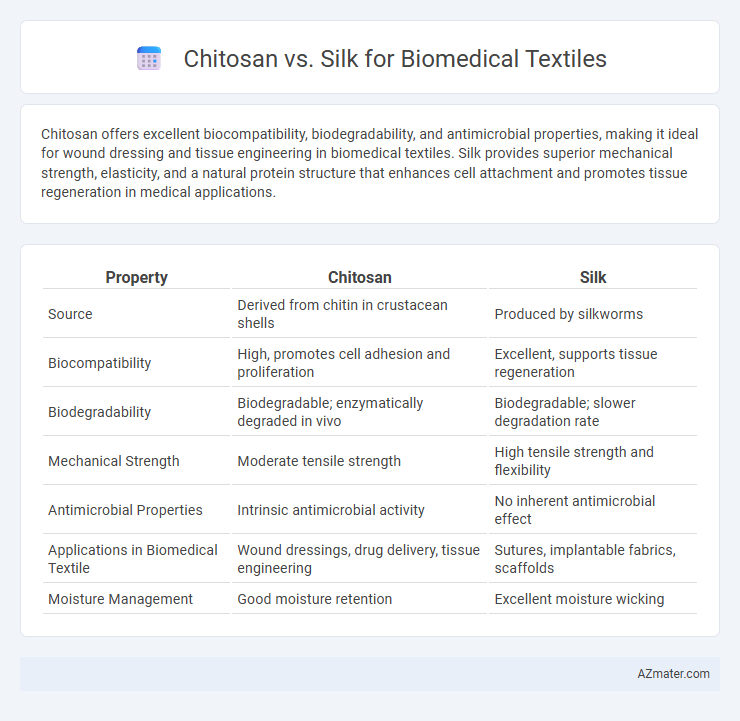Chitosan offers excellent biocompatibility, biodegradability, and antimicrobial properties, making it ideal for wound dressing and tissue engineering in biomedical textiles. Silk provides superior mechanical strength, elasticity, and a natural protein structure that enhances cell attachment and promotes tissue regeneration in medical applications.
Table of Comparison
| Property | Chitosan | Silk |
|---|---|---|
| Source | Derived from chitin in crustacean shells | Produced by silkworms |
| Biocompatibility | High, promotes cell adhesion and proliferation | Excellent, supports tissue regeneration |
| Biodegradability | Biodegradable; enzymatically degraded in vivo | Biodegradable; slower degradation rate |
| Mechanical Strength | Moderate tensile strength | High tensile strength and flexibility |
| Antimicrobial Properties | Intrinsic antimicrobial activity | No inherent antimicrobial effect |
| Applications in Biomedical Textile | Wound dressings, drug delivery, tissue engineering | Sutures, implantable fabrics, scaffolds |
| Moisture Management | Good moisture retention | Excellent moisture wicking |
Introduction to Biomedical Textiles
Biomedical textiles incorporate biocompatible materials designed to interact safely with biological systems, with chitosan and silk emerging as prominent choices due to their unique properties. Chitosan, derived from crustacean shells, offers antibacterial activity, biodegradability, and excellent wound healing capabilities, making it suitable for tissue engineering and drug delivery applications. Silk, produced by silkworms, provides superior mechanical strength, biocompatibility, and controlled biodegradation, ideal for sutures, scaffolds, and regenerative medicine.
Overview of Chitosan: Properties and Applications
Chitosan, a natural polysaccharide derived from chitin, exhibits exceptional biocompatibility, biodegradability, and antimicrobial properties, making it highly suitable for biomedical textiles. Its ability to promote cell adhesion and accelerate wound healing has led to widespread applications in wound dressings, drug delivery systems, and tissue engineering scaffolds. The unique cationic nature of chitosan enhances its interaction with negatively charged biological tissues, providing improved functionality over traditional materials like silk in specific medical contexts.
Silk in Biomedical Textiles: Key Features
Silk in biomedical textiles offers exceptional biocompatibility, tensile strength, and biodegradability, making it ideal for wound dressings, tissue engineering, and sutures. Its natural protein structure supports cell adhesion and proliferation, enhancing tissue regeneration and healing processes. Furthermore, silk's ability to be chemically modified allows for tailored drug delivery and antimicrobial properties in advanced medical applications.
Biocompatibility Comparison: Chitosan vs Silk
Chitosan and silk both exhibit excellent biocompatibility, but chitosan offers superior antimicrobial properties and promotes wound healing through its natural polycationic structure. Silk, renowned for its mechanical strength and minimal immune response, supports cell adhesion and proliferation, making it ideal for tissue engineering. Comparative studies indicate chitosan excels in antibacterial activity, while silk provides enhanced structural integrity, influencing material selection based on specific biomedical textile applications.
Mechanical Strength and Durability
Chitosan exhibits moderate mechanical strength and biodegradability, making it suitable for temporary biomedical textiles but often requiring reinforcement for load-bearing applications. Silk provides superior mechanical strength and elasticity, ensuring durability and long-term performance in biomedical devices such as wound dressings and implants. Combining chitosan with silk enhances the composite's mechanical properties while maintaining biocompatibility and controlled degradation rates.
Antimicrobial Properties: Chitosan vs Silk
Chitosan exhibits strong antimicrobial properties due to its polycationic nature, effectively inhibiting a broad spectrum of bacteria and fungi, making it highly suitable for biomedical textile applications. Silk, while biocompatible and mechanically robust, lacks inherent antimicrobial activity and often requires treatment with antimicrobial agents to achieve similar effects. The superior antimicrobial efficacy of chitosan enhances wound healing and reduces infection risk in biomedical textiles compared to silk.
Biodegradability and Environmental Impact
Chitosan exhibits superior biodegradability compared to silk due to its natural polysaccharide structure, enabling faster environmental decomposition and minimal ecological footprint. Silk, while biocompatible and biodegradable, degrades more slowly, leading to prolonged environmental persistence. The use of chitosan in biomedical textiles significantly reduces long-term waste accumulation and supports sustainable medical applications through its eco-friendly degradation properties.
Processing and Fabrication Techniques
Chitosan and silk exhibit distinct processing and fabrication techniques tailored for biomedical textiles; chitosan typically requires dissolution in acidic solutions followed by casting, electrospinning, or freeze-drying to form porous scaffolds. Silk, derived from silkworm cocoons, involves degumming, dissolution in solvents like lithium bromide, and subsequent fabrication via electrospinning, weaving, or knitting for enhanced mechanical properties. The choice between these methods directly influences the biocompatibility, mechanical strength, and degradation rates critical for tissue engineering and wound healing applications.
Cost and Commercial Availability
Chitosan, derived from crustacean shells, is economically viable due to its abundant raw material supply and low production costs, making it commercially accessible in biomedical textiles. Silk, produced from silkworm cocoons, incurs higher costs attributed to labor-intensive sericulture and limited large-scale processing, restricting its commercial availability. The cost-efficiency and widespread availability of chitosan position it as a more practical choice for scalable biomedical textile applications compared to silk.
Future Perspectives and Clinical Potential
Chitosan and silk both exhibit remarkable biocompatibility and biodegradability, making them prime candidates for advanced biomedical textiles with applications in wound healing, tissue engineering, and drug delivery systems. Future perspectives emphasize the integration of chitosan's antimicrobial properties with silk's superior mechanical strength to develop hybrid materials that enhance clinical outcomes in regenerative medicine and implantable devices. Ongoing clinical trials and material innovation suggest a growing potential for these biomaterials to revolutionize personalized medical textiles by improving functionality, reducing infection rates, and promoting faster tissue regeneration.

Infographic: Chitosan vs Silk for Biomedical textile
 azmater.com
azmater.com